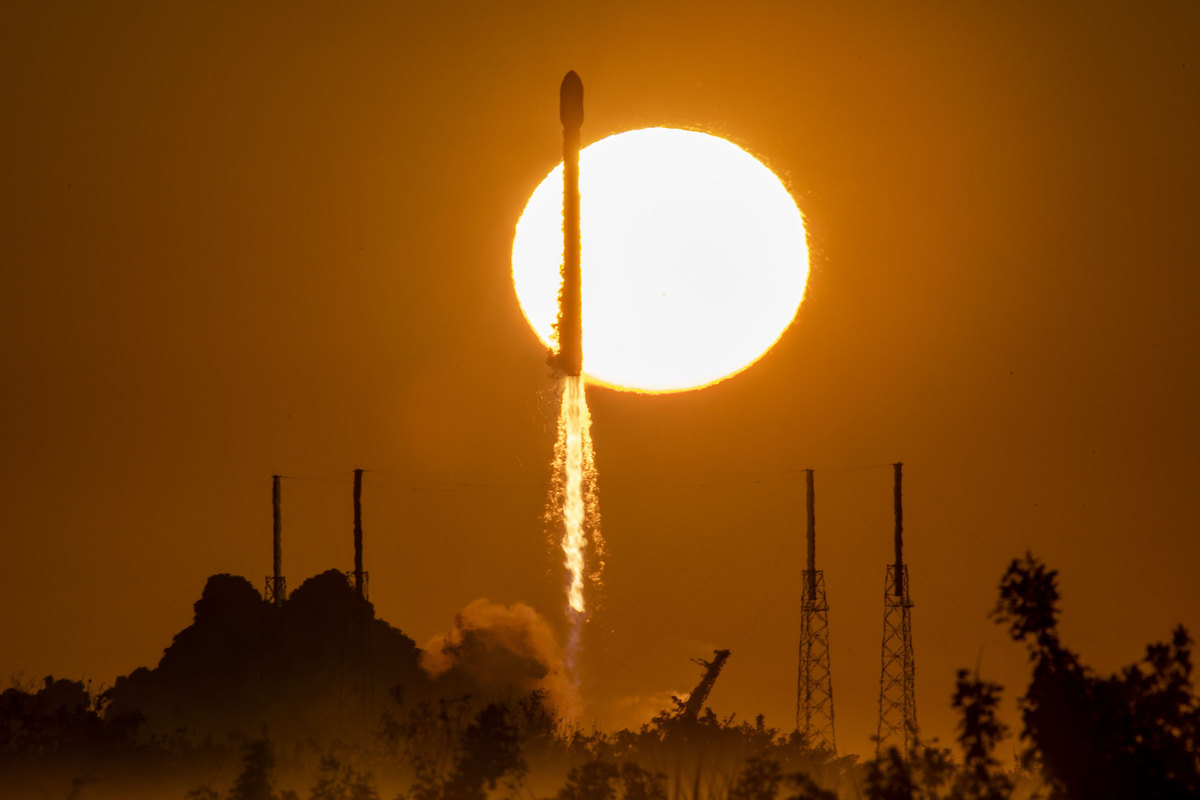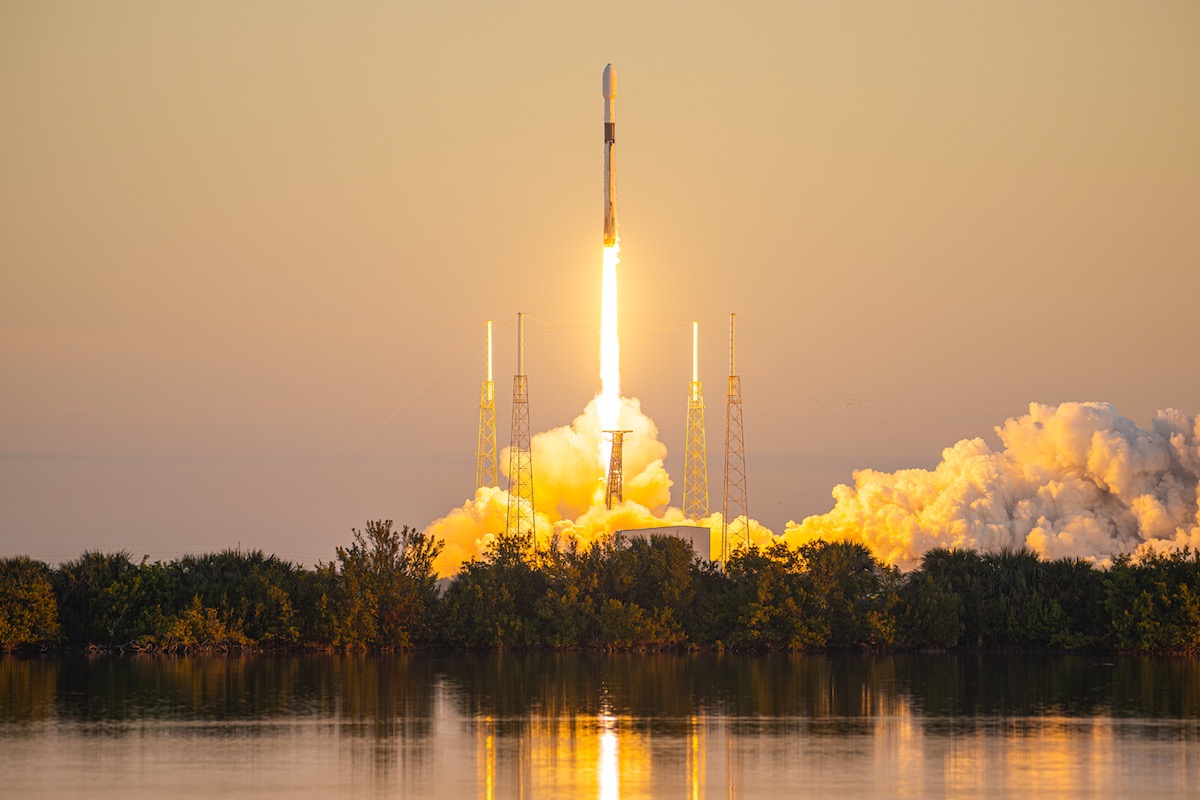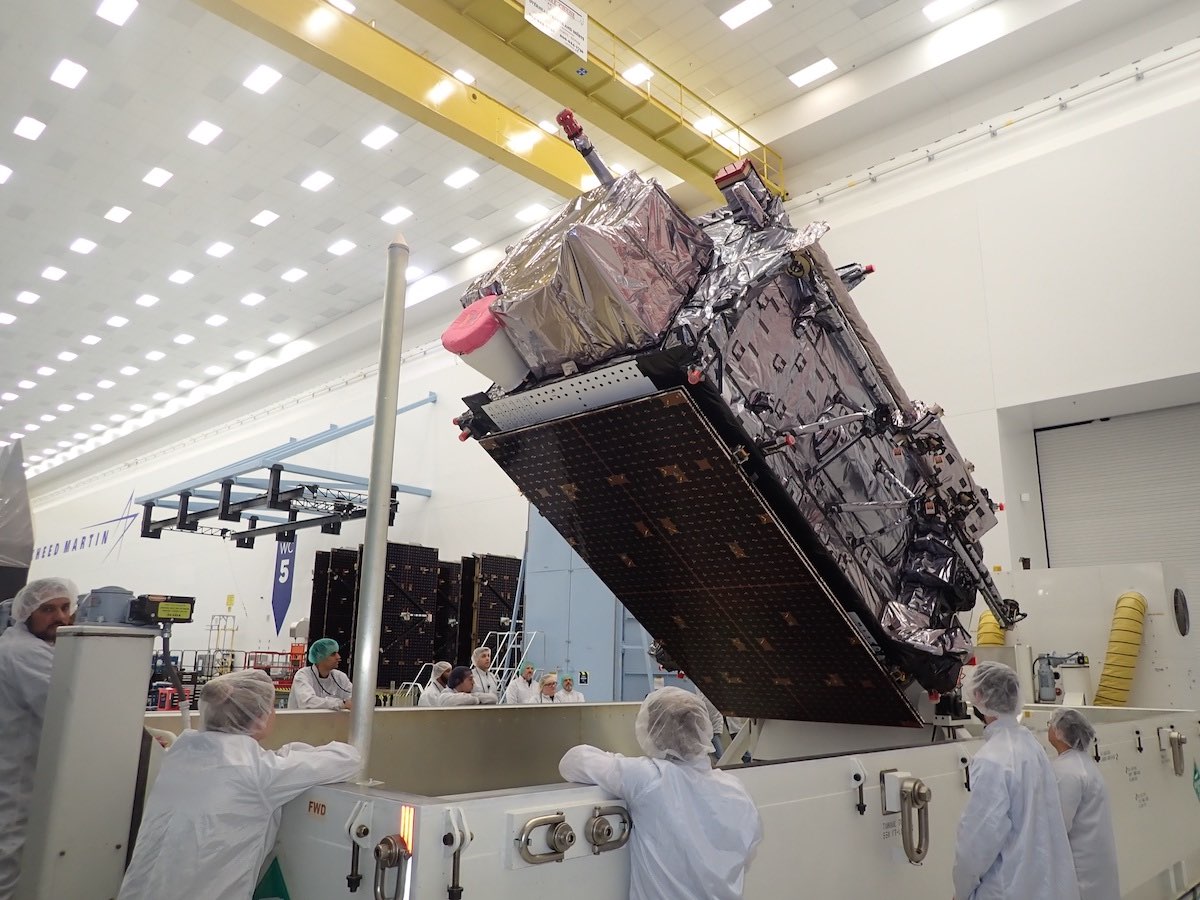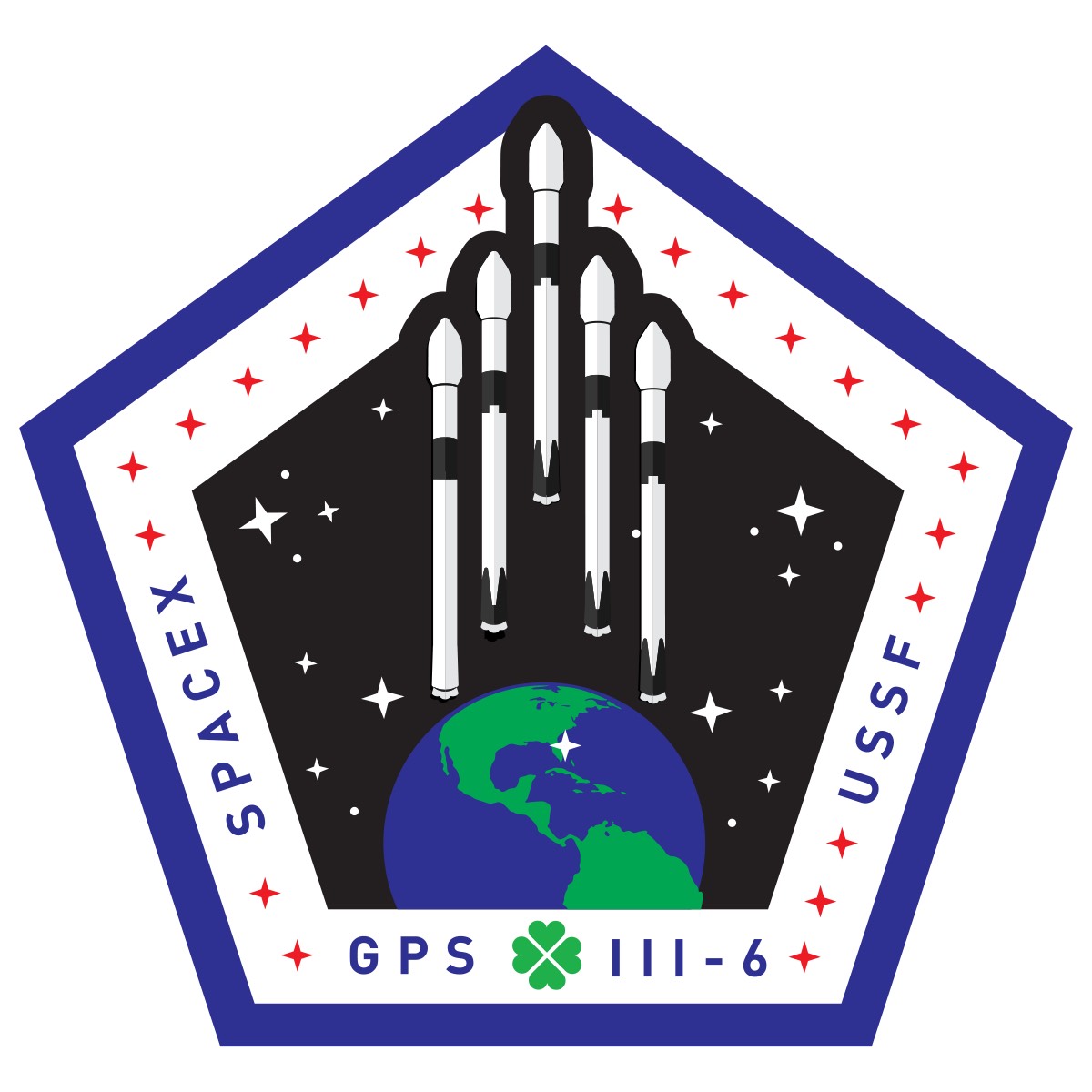Space News & Blog Articles
SpaceX delivers GPS satellite to 12,000-mile-high orbit
Watch a replay of our live coverage of the countdown and launch of a SpaceX Falcon 9 rocket at 7:24 a.m. EST (1224 GMT) on Jan. 18 from Space Launch Complex 40 at Cape Canaveral Space Force Station, Florida, with the GPS 3 SV06 navigation satellite for the U.S. Space Force. Follow us on Twitter.
SFN Live
SpaceX launched a Falcon 9 rocket just after sunrise Wednesday from Cape Canaveral, hauling a GPS navigation satellite into orbit to replace an aging 16-year-old spacecraft in the global positioning network trusted to guide everything from military weapons to civilian commuters.
The mission was the second SpaceX launch for the U.S. Space Force in less than three days, coming on the heels of a Falcon Heavy launch Sunday that accurately delivered two military satellites into a high-altitude geosynchronous orbit.
The launch Wednesday used SpaceX’s workhorse Falcon 9 rocket, and targeted a somewhat lower orbit to replenish the GPS satellite constellation circling some 12,550 miles (20,200 miles) above Earth.
The 229-foot-tall (70-meter) Falcon 9 rocket blasted off from pad 40 at Cape Canaveral Space Force Station at 7:24 a.m. EST (1224 GMT) Wednesday, less than 10 minutes after sunrise on Florida’s Space Coast. The launcher climbed away from pad 40 with 1.7 million pounds of thrust from its nine kerosene-fueled Merlin engines, then headed northeast over the Atlantic Ocean.
The liftoff was delayed 14 minutes to allow time for ground teams to resolve an issue with the GPS navigation satellite.
 SpaceX’s Falcon 9 rocket lifts off from pad 40 just after sunrise Wednesday, Jan. 18. Credit: SpaceX
SpaceX’s Falcon 9 rocket lifts off from pad 40 just after sunrise Wednesday, Jan. 18. Credit: SpaceX
The Falcon 9 surpassed the speed of sound in about a minute, then shut down its first stage around two-and-a-half minutes into the mission. The booster detached and descended to a propulsive landing about eight minutes after liftoff on a SpaceX drone ship floating in the Atlantic a few hundred miles east of Charleston, South Carolina.
The booster, known as B1077, completed its second flight to space, following a launch Oct. 5 with a crew of four heading for the International Space Station. The Falcon’s first stage will return to Cape Canaveral on the drone ship for refurbishment and reuse on a future mission.
An upper stage engine took over after the booster completed its role on Wednesday’s launch, propelling the new GPS navigation satellite into a preliminary parking orbit before coasting more than halfway around the world for another engine firing to power the payload into a higher orbit.
The second burn by the upper stage placed the GPS spacecraft into an orbit ranging between 243 and 12,528 miles (391-by-20,162 kilometers) above Earth. The orbit will take the satellite between 55 degrees north and south latitude on each lap around the planet.
The GPS 3 SV06 spacecraft deployed from the Falcon 9’s upper stage at 8:53 a.m. EST (1353 GMT), around 1 hour and 29 minutes after liftoff. A camera on-board the upper stage showed the Lockheed Martin-built satellite flying free of the rocket over the Pacific Ocean.
“This was a textbook launch, reflecting a highly professional, experienced team executing well-honed procedures and the results speak for themselves,” said Maj. Gen. Stephen Purdy Jr., program executive officer for Space Systems Command’s ‘Assured Access to Space’ division. “Working side-by-side with our launch service provider and space vehicle partner to meet the mission need on-time and with precision is our normal ops. And today’s mission supports not only our global warfighters but people all over the world in every facet of life.”
 Nine Merlin engines powered the Falcon 9 rocket off the launch pad with the GPS 3 SV06 satellite. Credit: Michael Cain / Spaceflight Now / Coldlife Photography
Nine Merlin engines powered the Falcon 9 rocket off the launch pad with the GPS 3 SV06 satellite. Credit: Michael Cain / Spaceflight Now / Coldlife Photography
The GPS 3 SV06 satellite is the sixth spacecraft in the latest generation of GPS 3-series satellite. After separation from the Falcon 9 rocket, the spacecraft was expected to unfurl its power-generating solar arrays and begin firing its own engine for orbit-raising maneuvers to reach a final position in a circular orbit approximately 12,550 miles above Earth.
The transit to the circular Medium Earth Orbit will take about two weeks under the control of Lockheed Martin engineers in Colorado. If all goes according to plan, the new satellite, nicknamed “Earhart” after the aviation pioneer Amelia Earhart, will be transitioned to the control of Space Force operators. GPs 3 SV06 is expected to enter operational service a few months after launch.
In its launch configuration fully fueled with propellant, the GPS 3 SV06 satellite weighed 9,595 pounds (4,352 kilograms), according to Col. Jung Ha, senior materiel leader for the GPS Space Vehicles Acquisition Delta at Space Systems Command.
The GPS 3 SV06 satellite will take a position in Plane A, Slot 2, of the GPS constellation, Ha said. The new spacecraft will replace a satellite in that position that launched Sept. 25, 2006, on a Delta 2 rocket from Cape Canaveral. The aging satellite, known as SVN 52 or GPS 2R-15, has operated for twice its original design lifetime.
The GPS satellites fly in six orbital groupings, with four slots in each group, for a minimum of 24 satellites to provide global coverage. The GPS network currently has 31 operational satellites.
Liftoff of SpaceX’s Falcon 9 rocket from Cape Canaveral with the US Space Force’s newest GPS navigation satellite. https://t.co/ZXQRog4JSY pic.twitter.com/leCR9tTUYH
— Spaceflight Now (@SpaceflightNow) January 18, 2023
Andre Trotter, Lockheed Martin’s vice president of navigation systems, said the company has four more GPS 3-series satellites ready for “call up” by the Space Force.
“We currently have four more GPS satellites in our Colorado facility that are available for launch and are prepared to answer the Space Force’s call,” Trotter told reporters Tuesday in a pre-launch news conference. Those satellites, numbered GPS 3 SV07 through SV10, are the final spacecraft in Lockheed Martin’s initial batch of GPS 3 satellites ordered by the Pentagon in 2008.
The next GPS satellite, GPS 3 SV07, is scheduled to launch in mid-2024 on a United Launch Alliance Vulcan rocket. It is a candidate to become the first national security payload to fly on ULA’s new Vulcan launch vehicle.
Construction of the first eight GPS 3 satellites is covered in a 2008 contract valued at $3.6 billion. The military ordered two additional GPS 3-type satellites later. The first GPS 3 satellite launched in 2018, and the most recent mission, SV05, launched in June 2021.
Military officials were unable to provide an exact cost for the GPS 3 SV06 spacecraft, but the average cost of each satellite in the 2008 purchase amounts to approximately $600 million in inflation-adjusted dollars.
The series of GPS 3 navigation satellites are designed for 15-year life spans, an improvement over the seven-and-a-half year and 12-year design lives of previous-generation GPS satellites. The GPS 3 satellites provide three times better accuracy and up to eight times improved anti-jamming capabilities over early GPS spacecraft, according to Lockheed Martin.
 The GPS 3 SV06 satellite prepared for shipment to Cape Canaveral from its Lockheed Martin factory near Denver. Credit: Lockheed Martin
The GPS 3 SV06 satellite prepared for shipment to Cape Canaveral from its Lockheed Martin factory near Denver. Credit: Lockheed Martin
The GPS 3 satellites also introduce a new L-band civilian signal that is compatible with other international navigation satellite networks, such as Europe’s Galileo program. Combining signals from GPS, Galileo, and other navigation satellites can improve the precision of space-based position measurements.
The U.S. military uses GPS satellites for smart bombs and other precision-guided munitions. Troops rely on the network, which requires a minimum of 24 satellites for global coverage, to provide positioning data pole-to-pole.
Lockheed Martin won a follow-on contract from the military in 2018 to build up to 22 more upgraded GPS 3F satellites. The Space Force has placed firm orders with Lockheed Martin for the first 10 GPS 3F satellites, which will provide the military with new capabilities such as enhanced regional protection and even better anti-jamming capabilities, an upgraded search and rescue payload, and a laser retroreflector array to help provide more accurate data on each spacecraft’s location in orbit, information that will result in more precise position information for users on the ground.
L3Harris Technologies builds the navigation payloads for the GPS 3 satellites.
Civilians use the Global Positioning System on their smartphones, and airliners employ augmented GPS signals for precision landings and in-flight navigation. Banks use the timing signals from GPS satellites to time tag financial transactions.
“GPS has become a part of our critical national infrastructure,” Trotter said.
 SpaceX’s mission patch for the GPS 3 SV06 launch. Credit: SpaceX
SpaceX’s mission patch for the GPS 3 SV06 launch. Credit: SpaceX
ROCKETS: Falcon 9 (B1077.2)
PAYLOAD: GPS 3 SV06
LAUNCH SITES: SLC-40, Cape Canaveral Space Force Station, Florida
LAUNCH DATES: Jan. 18, 2023
LAUNCH TIME: 7:24 a.m. EST (1224 GMT)
WEATHER FORECAST: Greater than 90% chance of acceptable weather at Cape Canaveral
BOOSTER RECOVERY: “A Shortfall of Gravitas” drone ship
LAUNCH AZIMUTH: Northeast
TARGET ORBIT: MEO transfer orbit; 250-by-12,550 miles (400-by-20,200 kilometers); 55 degrees inclination
LAUNCH TIMELINE FOR GPS 3 SV06
T+00:00: Liftoff T+01:12: Maximum aerodynamic pressure (Max-Q) T+02:33: First stage main engine cutoff (MECO) T+02:37: Stage separation T+02:45: Second stage engine ignition T+03:30: Fairing jettison T+06:19: First stage entry burn ignition T+06:44: First stage entry burn cutoff T+08:08: Second stage engine cutoff (SECO 1) T+08:09: First stage landing burn ignition T+08:33: First stage landing T+01:03:32: Second stage engine restart (SES 2) T+01:04:16: Second stage engine cutoff (SECO 2) T+01:29:17: Separation of GPS 3 SV06 satelliteMISSION STATS:
197th launch of a Falcon 9 rocket since 2010 207th launch of Falcon rocket family since 2006 2nd launch of Falcon 9 booster B1077 170th SpaceX launch from Florida’s Space Coast 110th Falcon 9 launch from pad 40 165th launch overall from pad 40 139th flight of a reused Falcon booster 6th Lockheed Martin-built satellite launched by SpaceX 5th GPS satellite launched by SpaceX 3rd Falcon 9 launch of 2023 4th launch by SpaceX in 2023 4th orbital launch from Cape Canaveral in 2023This email address is being protected from spambots. You need JavaScript enabled to view it. the author.
Follow Stephen Clark on Twitter: @StephenClark1.
When you subscribe to the SpaceZE News Feed, we will send you an e-mail when there are new updates on the site so you wouldn't miss them.

